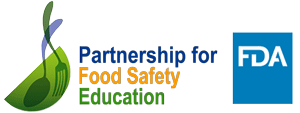About the Consumer Food Safety Educator Evaluation Toolbox and Guide
This resource was created by the Partnership for Food Education and the U.S. Food and Drug Administration as a planning and evaluation guide with tips, tools, and examples to help consumer food safety educators develop and evaluate their programs and activities. Development of the guide was informed by a survey administered by the Partnership for Food Safety Education. In the survey, the majority of a convenience sample of food safety educators (63%) indicated that they would like more training on evaluation. In addition, online educational materials focused specifically on the evaluation of consumer food safety education is limited, making a resource such as this guide important to have available to consumer food safety educators. Suggestions from a comprehensive assessment of consumer food safety education strategies also informed the guide’s content. Drafts of the guide were reviewed by ten health educators who provided feedback during drafting stages to improve content and usability. Reviewers included health educators at the U.S. Food and Drug Administration and six consumer food safety educators (BAC Fighters) who participated in one-on-one interviews.

Table of Contents
Chapter 1: Overview and Importance of Evaluation
- About this guide
- Background: foodborne illness and food safety
- Why evaluate?
- Evaluation standards
- In summary
- References
Chapter 2: Formative Program Planning
- Form a planning and evaluation team
- Select a team leader
- Build partnerships
- Identify the target audience
- Conduct a needs assessment
- Utilize behavior theories
- Identify program activities
- Identify communication/delivery strategies and core messages
- In summary
- References
Chapter 3: Mapping the Intervention and Evaluation
- Steps for a program evaluation
- Create a logic model
- Budget
- Levels of assessment
- Create a timeline
- Purpose of the evaluation
- Outcome evaluation
- In summary
- References
Chapter 4: Selecting an Evaluation Design
- Observational and experimental designs
- When to collect data
- Internal validity
- Use of a comparison/control group
- Probability and non-probability sampling
- Sample size
- Nonresponse
- In summary
- References
Chapter 5: Data Collection
- How to collect data
- Mixed methods
- Self-reported data
- Instrument/survey development
- Ways to administer a questionnaire
- Internal Review Board
- Informed consent
- Health Insurance Portability and Accountability Act
- In summary
- References
Chapter 6: Data Analysis
- Analyzing quantitative data
- Input data
- Clarify your objectives and approach
- Gather descriptive data
- Examine change and association
- Explore other factors
- Analyzing qualitative data
- In summary
- References
Chapter 7: Toolbox
- A tip sheet for evaluating educational presentations of consumer food safety information (e.g. workshop, class, training, or Webinar)
- A tip sheet for sharing and evaluating educational information online (e.g. brochures, fact sheets, infographic)
- A logic model template for planning and identifying program outcomes and indicators [adapted 3,4]
- A participant evaluation form you can use to evaluate educational presentations (e.g. workshop, class, training, or Webinar) [adapted 2]
- An activity tracker form for process evaluation and to track inputs and outputs [Question 18 – 1]
- A budget tracker form that you can use to plan your program budget or to track spending and expenses [adapted 5]
- Table templates to track Web and social media metrics
- An educational material feedback Form to gather usability data and feedback about your materials
- A PDF of the entire evaluation guide document.
- References